Wall 1: Colonialism in Viet Nam

In the 1860s
Indochina consisted of three countries:
Laos,
Cambodia, and
Viet Nam.
France took advantage of a dynastic struggle inside Vietnam
to establish a colony which eventually grew to control all of Indochina by the 1890s.
During
World War II (1941-1945), Japanese military forces occupied the colonies.
French forces reestablished their colonies after 1945.
French Withdrawal from Indochina
By 1946 the French government and its military forces came under attack by Vietnamese
nationalistic groups including the communist Viet Minh. On May 7, 1954
the Viet Minh military,
People’s Army of Viet Nam (PAVN), won a major victory against the French
at the
Battle of Dien Bien Phu. Partially because of this defeat, France announced
plans to leave Indochina. At a conference held in Geneva, Switzerland in July 1954,
it was agreed that Laos and Cambodia would become neutral, independent countries
and that Viet Nam would be divided in half along the 17th Parallel.
Communists under
Ho Chi Minh would control the north. The southern portion would be under
the control of non-communist groups with
Emperor Bao Dai, as Head of State and
Ngo Dinh Diem, as Prime Minister.
American Aid to South Vietnam
In response to the perceived threat of communism in South East Asia and Viet Nam
in particular, the United States established the Southeast Asian Treaty Organization (SEATO).
Members included the
United States,
Great Britain, France,
Australia,
New Zealand,
Pakistan,
Thailand and the
Philippines.
South Vietnam was made an associate member.
By 1955, the U.S. provided aid directly to the South Vietnamese government and helped
train its new army, the
Army of the Republic of Vietnam (ARVN).
Communist Insurgency Starts
Nationalistic groups and communists, known as
Viet Cong (VC), began armed resistance to the South Vietnamese government.
By the end of 1954, political and military insurrection had spread across South
Vietnam. The People’s Army of Viet Nam actively supported the Viet Cong by arming
37 guerilla companies in the
Mekong River Delta south of Saigon.
Wall 2: South Vietnamese and Americans React
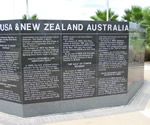
In 1955, the U.S. provided military advisors to the South Vietnamese government.
On December 11, 1961, 33 U.S. helicopters with 380 crewmen and pilots arrived in
Saigon. Although direct American involvement in combat was rare at this early stage,
the first two U.S. soldiers were killed on July 8, 1959, Major Dale Buis and SGT
Chester Ovnand. By December 1962, there were 11,300 U.S. military advisors in South
Vietnam.
The Viet Cong began military action against hamlets, provinces, government officials,
and ARVN. By the end of 1965, approximately 1,500 ARVN soldiers had been killed
in action (KIA).
On January 2, 1963, Viet Cong troops in battalion size units attacked and defeated
ARVN troops at
Ap Bac. This was the largest battle between ARVN and Viet Cong to date.
By the end of 1963, U.S.
President John F. Kennedy had increased the number of U.S. advisors in South
Vietnam to 16,300.
On August 2, 1964, the
USS Maddox was attacked off the coast of North Vietnam by North
Vietnamese gunboats. A second attack was reported by the USS Maddox and the USS Turner Joy
on August 4th.
As a result of these reports,
President Lyndon B. Johnson ordered U.S. planes to strike military targets
along the coast of North Vietnam. The attacks destroyed 25 North Vietnamese patrol
boats and damaged fuel storage depots. U.S. Air Force Lieutenant Everett Alvarez
was shot down and became the first U.S. pilot prisoner of war (POW).
On August 7, 1964, Congress supported President Johnson’s request to use force in
South Vietnam. This congressional action was known as the “Gulf of Tonkin Resolution”.
In support, the U.S. Air Force began “Operation
Rolling Thunder” from March 1965 through November 1968 which called for
gradual escalation of bombing in North Vietnam to convince the PAVN to stop supporting
the Viet Cong. Over 640,000 tons of bombs were dropped and 922 U.S. aircraft were
lost from all causes as a result of this campaign.
South Vietnamese and U.S. Advisors in Combat
By the end of 1965, Republic of Viet Nam has armed forces of about 354,000. About
25,000 U.S. advisors served with the ARVN.
From 1954-1965, the Viet Cong and PAVN communist guerillas grew from squad level
to division size. By June 9, 1965, the 9th Viet Cong Division of 1,500
troops launched an attack against
U.S. Special Forces troops, U.S.
Navy Seabees, and ARVN soldiers at
Dong Xoai, north of Saigon.
The three day battle (June 9-12) began with the Viet Cong partially taking the camp.
ARVN airmobile units of the
42nd Ranger Battalion and U.S. Advisors counterattacked, arriving
by helicopters flown by American and Vietnamese pilots. Among the KIAs were 300
ARVN, 60 civilians, 22 U.S. advisors, and 600 Viet Cong. The Battle of Dong Xoai
was the first offensive by Viet Cong forces targeting Saigon. Army Second
Lieutenant Charles Q. Williams was awarded the Medal of Honor for
his heroic actions in this engagement.
Wall 3: U.S. Combat Troops Enter the War
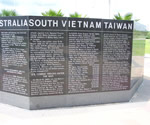
On March 8, 1965, the 9th Marine Expeditionary Brigade arrived in Da Nang and
was the first American Combat Brigade to land in South Vietnam. By April 10, 1965,
the 2nd and 3rd Marine Battalions landed, bringing the total
numbers of U.S. Marines operating around Da Nang to 6,000. From August 18-25, 1965,
the Marine Brigade combined with elements of U.S. artillery, helicopters, aircraft
and naval bombardment from the
USS Galveston and the
USS Cabildo conducted “Operation
Starlite”.
Corporal Robert E. O’Malley became the first U.S. Marine to
receive the Medal of Honor in South Vietnam as a result of this action. The U.S.
suffered 29 killed in action (KIA) and 71 wounded in action (WIA), the Viet Cong
had 281 KIA.
By the end of 1965 there were over 18 combat battalions and one Special Forces Group
in South Viet Nam.
Unit Date Arrived - Date
- 5th Special Forces Command - 10/01/1964
- 3rd Marine Regiment, 3rd Marine Division - 05/06/1965
- III Marine Amphibious Force - 05/07/1965
- 4th Marine Regiment, 3rd Marine Division - 05/07/1965
- 173rd Airborne Brigade - 05/07/1965
- 9th Marine Regiment, 3rd Marine Division - 07/06/1965
- 2nd Brigade, 1st Infantry Division - 07/01/1965
- 1st Brigade, 101st Airborne Division - 07/29/1965
- 1st Cavalry Division - 09/11/1965
- 18th Combat Engineer Brigade - 09/20/1965
- 3rd Brigade, 1st Infantry Division - 10/02/1965
- 1st Brigade, 1st Infantry Division - 10/06/1965
In 1964,
Lieutenant General William C. Westmoreland became Commander of all U.S.
forces in South Vietnam. South Vietnam was divided into four military corps. I Corps
included the 5 northern provinces up to the
Demilitarized Zone (DMZ) at the 17th parallel and included the
cities of Da Nang and
Hue. The mountainous middle of the country made up II Corps, including the
naval depot at
Cam Ranh Bay. The capital city of Saigon and the eight provinces to the
north of the city were III Corps. The Mekong Delta, south of Saigon, was part of
IV Corps.
Army pilots and Navy and Marine aviators provided close air support for ground troops.
The U.S. Air Force provided close air support through the 440th Combat
Crew Training Squadron at
Bien Hoa from 1961 to 1966. A buildup of forces in April of 1966 required
reorganization under the 7th Air Force based at Ton Son Nhut. Wing commands
for combat aircraft were located at Bien Hoa, Cam Rahn Bay, Phan Rang, and Da
Nang.
Initially, the Strategic Air Command conducted B-52 missions with the 133rd
Provisional Wing operating from
Guam. Later B-52 raids originated in Thailand and Okinawa. Eventually, B-52
raids were conducted into Laos and Cambodia to disrupt NVA supply lines.
Naval missions were run by the 7th Fleet divided into different task
forces. Task Force 77 was the Carrier Attack Group which flew air support and bombing
missions, including “Operation
Rolling Thunder”, the continuous bombing of North Vietnam between March
1965 and November 1968. Between 1965 and 1975, 19 different aircraft carriers were
part of this task force. Amphibious units were assigned to Task Force 76, Task Force
73 provided logistical support. Cruisers and destroyers were assigned to offshore
bombardment in Task Force 70.8. Task Force 117 operated small vessels on rivers,
especially in the Mekong Delta.
Unit Arrived - Date
- 1st Brigade, 101st Airborne Division - 07/1965
- 25th Infantry Division - 12/1965
- 4th Infantry Division - 09/1966
By the end of 1965 the U.S. forces increased from 23,300 to 184,300 with 656 U.S.
killed in action.
Wall 4: Plei Me and the Ia Drang Valley
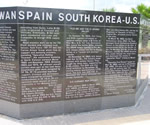
On October 19, 1965, Viet Cong and NVA regulars attacked an isolated military camp
in II Corps at Plei Me. The U.S. 1st Cavalry Airmobile Division soon
joined the battle. After relieving the ARVN troops fighting at Plei Me, U.S. troops
moved into the
Ia Drang Valley in a “search and destroy” mission.
On November 14, 1965, U.S. forces from the 1st Battalion, 7th
Cavalry made contact with enemy forces. They fought for three days, supported by
B-52 strikes. The NVA and Viet Cong withdrew by November 16th leaving
behind approximately 1,770 dead. The U.S. had 300 killed in action. In November
the enemy retreated into nearby Cambodia.
U.S. Expands War Effort
From January 1966 to March 1966, United States, ARVN and Korean forces conducted
“Operation
Whitewing/Masher” in the valleys of
Binh Dinh Province in II Corps. Troops of the U.S. 1st Cavalry
Division, ARVN’s Airborne Brigade and 22nd Infantry Division and the
1st Regiment of the Republic of Korea’s Capital Division attacked enemy
forces in the area.
On March 19, 1966, the North Vietnamese Army (NVA) 1st Regiment besieged
South Vietnamese Regional Forces at the village of An Hoa. A counterattack led by
the 3rd Battalion of the 4th Marines, and the 5th
ARVN Airborne Brigade, broke through the siege lines and destroyed the enemy in
“Operation Texas” ending by March 24th.
“Operation Paul Revere” began on May 19, 1966, and ran to December 30, 1966. The
plan was to disrupt NVA and VC activity near the Cambodian border. Elements of the
4th Infantry Division, 25th Infantry Division, and the 1st
Cavalry Division attacked the 1st NVA Division operating near Pleiku in South
Vietnam’s central highlands. The NVA suffered approximately 4,000 casualties and
retreated into Cambodia.
U.S. troops continued to arrive in South Vietnam.
Unit - Date Arrived
- 1st Marine Division - 02/23/1966
- 44th Medical Battalion - 04/1966
- 196th Light Infantry Brigade - 08/1966
- 11th Armored Cavalry - 09/08/1966
- 5th Marine Division - 09/1966
- 18th Engineer Brigade - 09/1966
- 199th Light Infantry Brigade - 12/16/1966
- 9th Infantry Division - 12/16/1966
By the end of 1966, the U.S. had 385,300 troops in South Vietnam with 6,644 killed
in action by December 31, 1966.
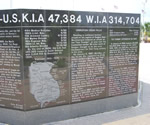
Reacting to continued terrorist attacks in the capital of Saigon, General Westmorland
ordered an attack on the “Iron
Triangle”, an area near the Cambodian border 20 miles north of Saigon, thought
to be the main headquarters for Viet Cong activity in the area.
On January 8, 1967, 2nd Brigade of the 1st Infantry Division
supported by B-52 strikes landed in Ben Suc, the “hub” of the triangle. They discovered
large amounts of supplies. The 173rd Airborne and 11th Armored
Cavalry acted as a hammer pushing the enemy into the arms of the 25th
Infantry Division, 196th Light Infantry Brigade and 35th ARVN
Ranger Battalion. By January 26th, the operation ended with approximately
250 U.S. casualties and 775 enemy troops killed in action or captured. Over 500
miles of tunnels were destroyed along with the village of Ben Suc.
By the end of 1967, total U.S. forces numbered 485,600. U.S. KIAs were 16,021. U.S.
units sent to South Vietnam that year were the following:
Unit - Date Arrived
- 20th Engineer Brigade 08/1967
- 23rd Infantry Division 11/1967
In January of 1968, between 25,000-40,000 NVA troops of the 325C, 304, 320, and
324 Divisions surrounded approximately 6,000 of the 3rd and 26th
U.S. Marines at
Khe Sahn, 18 miles south of the DMZ. U.S. air units dropped over 100,000
tons of bombs in “Operation
Niagara” in an attempt to end the siege. The NVA eventually withdrew in
March and elements of the 1st Cavalry Division occupied the area.
On January 31, 1968, Viet Cong and NVA units launched attacks focused on the central
highlands and major population areas across South Vietnam. Five of six major cities
and 36 of 44 provincial capitals came under attack. The enemy mobilized over 100,000
troops for the attack. The capital city of Saigon was a special target including
the U.S. Embassy. The NVA achieved momentary victory when they took the city of
Hue on January 31, 1968.
The 1st Air Cavalry, 101st Airborne Division, 1st
U.S. Marines, 1st Infantry Division ARVN, and ARVN Rangers counterattacked
that day but did not retake the city until the Citadel fell on February 24, 1968.b
Casualties - KIA - WIA
- U.S. 216 1,364
- ARVN 384 1,830
- NVA and VC 5,000 Unknown
- Civilians 6,000 Unknown
The North Vietnamese Army (NVA) and Viet Cong (VC) lost an estimated 40,000 troops
in the Tet campaign and the VC were decimated to the point of no longer being a
serious threat. U.S. casualties were 1,100 killed in action and ARVN lost 2,300
killed in action. The Tet offensive shocked Americans at home who believed that
the war was coming to a successful conclusion.
At the end of 1968, U.S. troops totals had risen to 536,000 including:
Unit - Date Arrived
- 82nd Airborne Division 02/18/1968
- 1st Brigade, 5th Infantry Division 06/25/1968
In the bloodiest year of fighting yet, the U.S. had 14,599 KIA, almost double the
deaths of all the years in South Vietnam up to that point, bringing the total U.S.
KIA to 30,610.
Wall 6: Antiwar Movement
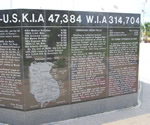
Antiwar protests began at the start of U.S. involvement in South Vietnam. By 1968
antiwar protests swept across the country causing personal and political turmoil.
President Lyndon Johnson decided not to run for reelection largely because of the
antiwar protests.
On March 28, 1968, 200,000 antiwar protestors marched in New York City. The protests
reached a high point when U.S. troops entered Cambodia in 1970. At Kent State,
National Guardsmen fired at student protestors on May 4, 1970. Ten days later police
killed two students in a similar protest at Jackson State. Combined casualties were
6 students killed and 14 wounded.
Vietnamization and De-escalation Under Nixon
U.S. troops strength was 543,300 on April 30, 1969. As part of his “Vietnamization
Plan”,
President Nixon announced the removal of 25,000 troops by the end of 1969.
During that year, the following units withdrew from South Vietnam:
Unit - Date Arrived
- 9th Infantry Division 08/27/1969
- 3rd Marine Division 11/11/1969
- 3rd Brigade, 82nd Airborne Division 12/1969
Other U.S. forces remained in action in South Vietnam. On May 10, 1969, the 9th
Marine Regiment and the 101st Airborne Division began “Operation Apache
Snow”, moving into the
A Shau Valley in
Thua Thien Province. Once battle occurred around Dong Ap Bai, nicknamed
“Hamburger
Hill”. For 11 days, the 101st Airborne Division assaulted the
enemy’s fortified hill at a high cost to both sides. The enemy withdrew across the
border to Laos and U.S. troops evacuated the region.
In 1969 approximately 475,200 U.S. troops remained in South Vietnam. U.S. casualties
were 9,414 KIA that year, b ringing the total U.S. KIA to 40,024.
Wall 7: Cambodia in 1970
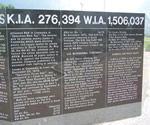
On May 6, 1970, the 4th U.S. Infantry Division and the 49th
ARVN Regiment attacked NVA in Cambodia in “Operation Binh Tay”. The mission was
to destroy enemy bases in Cambodia which were starting points and supply routes
for enemy activities in South Vietnam. By May 16, the 4th Infantry Division
withdrew and turned the entire operation over to ARVN. Because of public outcry
in the U.S. against the Cambodian invasion, Congress prohibited U.S. personnel from
fighting or advising troops in Cambodia or Laos on December 22, 1970.
“Operation Texas Star” was conducted in I Corps in Quang Tri and Thua
Thien Provinces by the 101st Airborne Division and the ARVN 1st
Infantry Division. The operation began on April 1, 1970 and continued to September
5th of that year, accounting for approximately 1,788 enemy casualties.
Both of these campaigns were carried out even as the U.S. continued to reduce its
forces in South Vietnam.
Unit - Departed
- 1st Infantry Division 04/1970
- 3rd Brigade, 9th Infantry Division 09/1970
- 4th Infantry Division 12/1970
- 25th Infantry Division (-) 12/1970
By December 1970, 334,600 U.S. personnel remained in Vietnam. The U.S. had 4,221
killed in action during 1970 bringing the total number of Americans killed in the
war to 44,245.
United States Withdrawal Continues
As U.S. forces withdrew, the fighting was turned over to ARVN troops. The last great
U.S. and ARVN offensive was “Operation
Jefferson Glenn” (September 5, 1970 – October 8, 1971). The 101st
Airborne Division and the ARVN 1st Infantry Division attacked enemy forces
and established fire bases for the ARVN to attack enemy troops in Thua Tien Province.
The enemy suffered over 2,000 casualties. On November 12, 1971, President Nixon
announced U.S. forces would take on a defensive role in that war.
A desire to limit U.S. casualties prompted the following U.S. withdrawals in 1971:
Units
- 5th Special Forces Group
- 11th Armored Cavalry Division
- III Marine Amphibious Force
- 1st Cavalry Division
- 2nd Brigade, 25th Infantry Division
- 173rd Airborne Brigade
- 1st Brigade, 5th Infantry Division
By December of 1971, U.S. military strength was 156,800. U.S. had 1,381 killed in
action that year bringing the total number of Americans killed in the war to 45,626.
Bombing and Peace Talks
In March of 1972, as the U.S. began its final withdrawal, the North Vietnamese Army
(NVA) began an all out offensive. The goals of the NVA “Eastertide Offensive”
were to take all of South Vietnam or to gain enough ground for a better bargaining
position at the peace talks. Three NVA divisions supported by T-54 Soviet made
tanks attacked across the Demilitarized Zone aimed at Hue. Another three divisions
attacked Binh Long Province and surrounded
An Loc. Another prong attacked Kontum in the central mountains. Other NVA
attacks occurred along the coast. Many of the attacks failed to take major cities
as ARVN troops held their ground supported by U.S. air cover, but the NVA did make
gains in the countryside despite considerable losses. It is estimated the NVA lost
100,000 killed in action in the offensive which ended by the middle of 1972.
“Operation
Linebacker 1” (April 2, 1972 to October 22, 1972) bombed PAVN supply trails
to disrupt their actions against the ARVN. When negotiations stalled, President
Richard Nixon began the bombing of Hanoi on April 15, 1972, to encourage the North
Vietnamese to participate in peace talks. By May 8, the U.S. Navy began mining Haiphong
Harbor.
Despite the continuing conflict, the 101st Airborne Division, 3rd
Brigade of the 1st Cavalry Division, 196th Infantry Brigade,
and the 3rd Marine Division withdrew from South Vietnam in 1972. By the
end of the year, 24,000 U.S. troops remained in South Vietnam. The U.S. had 312
killed in action that year.
Wall 8: Peace Pact and Eventual End of the War
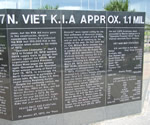
On January 27, 1973, the “Paris
Accords” were signed calling for the final withdrawal of American troops,
a cease-fire, the return of U.S. prisoners of war (POWs) and an end to all bombing
by the middle of the year. On that same day, Lieutenant Colonel William Nolte became
the last American killed in combat at An Loc. By August 14, 1973, all U.S. operations
in South Vietnam ceased, leaving 50 U.S. advisors. The North Vietnamese began releasing
U.S. POWs up to March 29, 1973, when the last 67 of 587 POWs released by the North
Vietnamese returned home. On May 7, 1973,
President Gerald Ford declared U.S. military activity officially over. Total
U.S. forces killed in action, died from non-hostile action, and missing in action
in the war were 58,235. 7,465 women served (1954-1973). Among these were 6,254 nurses
and medical specialists, 734 from the Women’s Army Corps, 433 from the Air Force,
12 with the Navy and 36 female Marines. T. Sharon Lane, an army nurse, was the only
female killed in action.
By 1975, the North Vietnamese began the final attack, seizing Saigon. From April
29-30, 1975 the last 1,375 Americans were evacuated by Marine helicopters in “Operation Frequent Wind”.
North Vietnam absorbed South Vietnam.
Vietnam War Statistics
United States and Allies in Vietnam
Nation - Peak Troop Strength
- Australia - 7,672
- New Zealand - 550
- South Korea - 48,869
- South Vietnam - 1,048,000
- Spain - 13
- Taiwan - 31
- Thailand - 11,568
- United States - 543,418
Enemy Troops
- North Vietnamese Army/Viet Cong - 924,400
Casualties as of 2003
United States and Allies in Vietnam
Nation - KIA - WIA
- Australia - 469 - 2,940
- New Zealand - 35 - 212
- South Korea - 4,407 - 17,060
- South Vietnam - 223,748 -1,169,763
- Thailand - 351 - 1,358
- United States - 47,384 - 314,704
Enemy Casualties (Estimated)
- North Vietnamese Army/Viet Cong - 1,100,000 KIA - 600,000 WIA